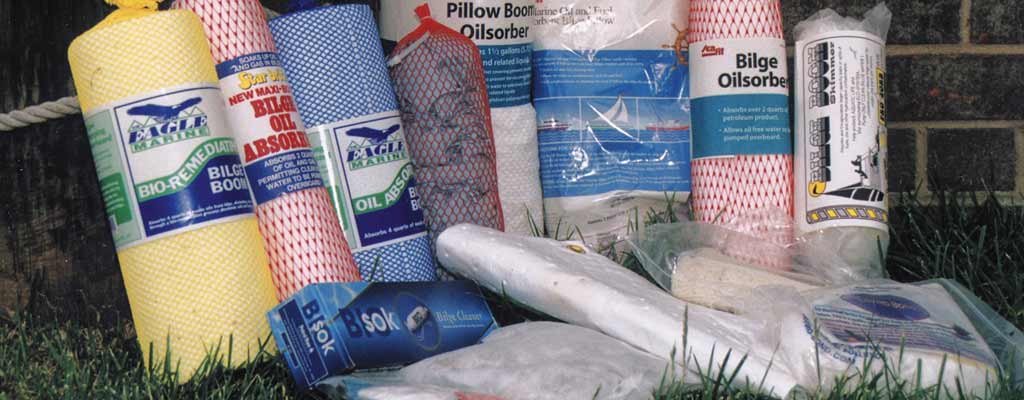Fuel Spill Prevention Products
In addition to practicing safe and smart fueling techniques, there are a number of products on the market that can help you prevent fuel spills.
Absorbents
Oil-only absorbent products soak up hydrocarbons - gasoline, diesel fuel, oil, hydraulic fluids - but not water. These products work like a sponge and make spill clean-up easy. Absorbent products come in many shapes and sizes. They can be placed in the bilge to soak up oil, used around a fuel nozzle to catch backsplash or even floated on the surface of the water to collect a sheen.
Most of these products simply absorb the oil and fuel. When saturated, they can be wrung out over an oil recycling bin and reused or disposed of properly. Some absorbents harden into a gel-like substance after coming in contact with hydrocarbons. This eliminates the problem of dripping pads and may allow for easier disposal.
Other absorbent products contain naturally occurring microbes that "eat" hydrocarbons. This approach is called bioremediation and requires the presence of a small amount of water, air temperature above 40 degrees and several days or weeks to be effective. In theory, after given enough time, the microbes will consume all of the oil or fuel, leaving behind clean water. Bioremediating products should help solve some of the disposal challenges but do require time to get the job done.
A Note About Bioremediation
The BoatU.S. Foundation has not verified the claims of the various bioremediating products on the market. Absorbent products such as booms and socks containing microbes are classified as "mixed products" by the EPA. Boaters may use bioremediation products in a contained form (sock or boom) in the bilge of a boat. It is not legal for boaters to use loose or contained bioremediation products on a spill in open water. Only a trained spill response professional can apply mixed products or bioremediation products to an open water spill.
Additionally, it is illegal for any boater to pour loose remediation products or spray any remediation products on the water at anytime.
- Fuel Bib Shaped like a small baby bib. Slides over fuel filler neck to catch drips and overflow.
- Absorbent Pads Look like a cloth diaper. Use them like a paper towel or sponge to absorb fuel/oil while leaving the water behind.
- Bilge Sock Looks like an athletic sock filled with absorbent material. They can fit into tight places under the engine or in the bilge.
- Spill Booms Sausage shaped absorbents that can be hooked together to put around a boat, dock or large spill.
- Fuel Bib Shaped like a small baby bib. Slides over fuel filler neck to catch drips and overflow.
Mechanical
Some changes made to gasoline boat fuel systems starting with model year 2013 have greatly reduced the likelihood of a spill. Below are some products that can help prevent spills in older boats or diesel fuel systems.
- Vented Deck Fills This device combines the fuel vent hose (that usually vents overboard) with the deck fill, allowing vented fuel to flow back into the fuel tank. Vented deck fills are installed in place of the factory installed deck fill. The hose from the fuel tank vent is redirected back into the neck of the deck fill itself, so the excess fuel will flow back into the tank instead of into the water. It can also make it easier to hear when the tank is getting full as the vent sounds will be right at the fill.
- Fuel Whistle This device fits inline in your vent hose. As the tank fills up it displaces air through the vent. This air causes the whistle to make a sound. As the tank becomes full and the air flow stops and the sound of the whistle also stops. This simple device works in many boats. Though the location of your boat's vent will determine how easily you can hear the whistle while fueling.
- Fuel Vent Collection This device captures overflow from the fuel tank vent. It is mounted temporarily on the exterior of boat during fueling. It attaches with suction cups over the fuel vent. If a spill occurs from the vent, the device captures any excess fuel, preventing it from entering the water. Any captured fuel can be poured back into the boat’s tank. This product has become harder to find on the market, but many clever boaters could likely make one.
- Fuel Air Separators An inline fuel/air separator is a device installed along the vent hose that prevents fuel from escaping at the vent by the use of a small ball valve. When the fuel enters the vent line the ball valve closes off the vent, preventing fuel from spilling.
To learn more about mechanical products for preventing spills, visit our review of various prevention products.

